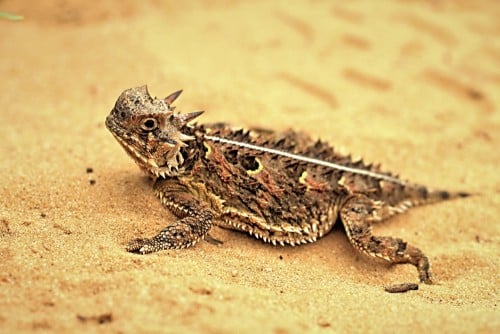Scientists have revealed how water is transported through channels in the skin of a Texas lizard to its mouth, and copied the principles of water transport in a plastic version.

By: Yael Halfman Cohen
The Texas horned lizard is known as one of the reptiles that excels in transporting water through capillary channels on the skin directly towards the mouth. These lizards usually live in dry areas, and they are able to collect water from anywhere, even from the sand on which they walk. The collected water is transported to the mouth, without Energy investment, through a network of capillary channels located between the scales of the skin, which partially close them. The lizard's skin is able to passively move fluids in a certain direction faster than in other directions, and this is independent of the location of the water on the skin. Water can be on the back, in front or on the tail, and they are always led the fastest towards the mouth.
Canals are one of the recurrent structures in nature related to the function of transport. A German-Austrian team, which recently studied the structure of the lizard's skin and its complexity, identified two key principles that enable the passive transport of water in the channel network. These principles are a breakthrough in research recently published in The Journal of the Royal Society Interface.
The first principle is the fact that the structure of the grooves is concave and they get narrower towards the mouth of the lizard. The more concave the groove, the greater the capillary force driving the fluids forward towards the mouth.
The second principle found is the connection between channels. Water can be carried away at one junction, but will later be "collected" by water flowing in a neighboring channel. The narrowness of each concave channel, along with the connection between the channels, are the two principles that explain the movement of water and its direction.
These principles were used to design two biomimetic surfaces. The team did not attempt to produce an exact replica of the lizard's skin structure due to manufacturing limitations, but based on the two principles found in the study, the research team produced two simple glass-like plastic surfaces, with channels created by a laser and protruding scales between them. Although the replica is not exact, on both surfaces the water was channeled faster in a certain direction than in other directions.
This research is a beautiful example of biomimetic research in which the movement of water on a lizard's skin is observed, its design principles are discovered and engineering applications are sought. The researchers suggest the use of direct passive transfer of liquids in stills, heat exchangers, or small medical devices where condensation is a problem. The group is already investigating whether the discovery could help transfer lubricants to internal areas within machines, areas where they are needed.
Until then, you have to remember, of course, that there is a limit of scale. The solution in nature is at the micro level, and of course it will not be possible to raise water to high floors in this way...
Source of knowledge
